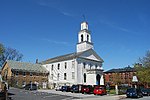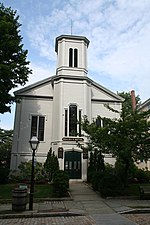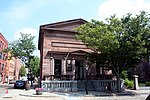Times and Olympia Buildings
Bristol County, Massachusetts Registered Historic Place stubsBuildings and structures in New Bedford, MassachusettsHistoric district contributing properties in MassachusettsNRHP infobox with nocatNational Register of Historic Places in New Bedford, Massachusetts ... and 4 more
Newspaper buildingsNewspaper headquarters in the United StatesOffice buildings on the National Register of Historic Places in MassachusettsUse mdy dates from August 2023

The Times and Olympia Buildings are a pair of historic buildings in central New Bedford, Massachusetts. The Times Building, also known as the Slocum or Evans Building, stands at 908–912 Purchase Street, and was built in 1897 to a design by Nat. C. Smith. Originally a furniture store, it was home to the New Bedford Times until the 1950s. The Olympia Building stands next door; it was designed by Mowll & Rand of Boston and built in 1921. It is a four-story brick building, with shops on the ground floor and offices above.The buildings were listed on the National Register of Historic Places in 1983.
Excerpt from the Wikipedia article Times and Olympia Buildings (License: CC BY-SA 3.0, Authors, Images).Times and Olympia Buildings
Pleasant Street, New Bedford
Geographical coordinates (GPS) Address Nearby Places Show on map
Geographical coordinates (GPS)
| Latitude | Longitude |
|---|---|
| N 41.636388888889 ° | E -70.926666666667 ° |
Address
Bank of America
Pleasant Street 700
02740 New Bedford
Massachusetts, United States
Open on Google Maps









